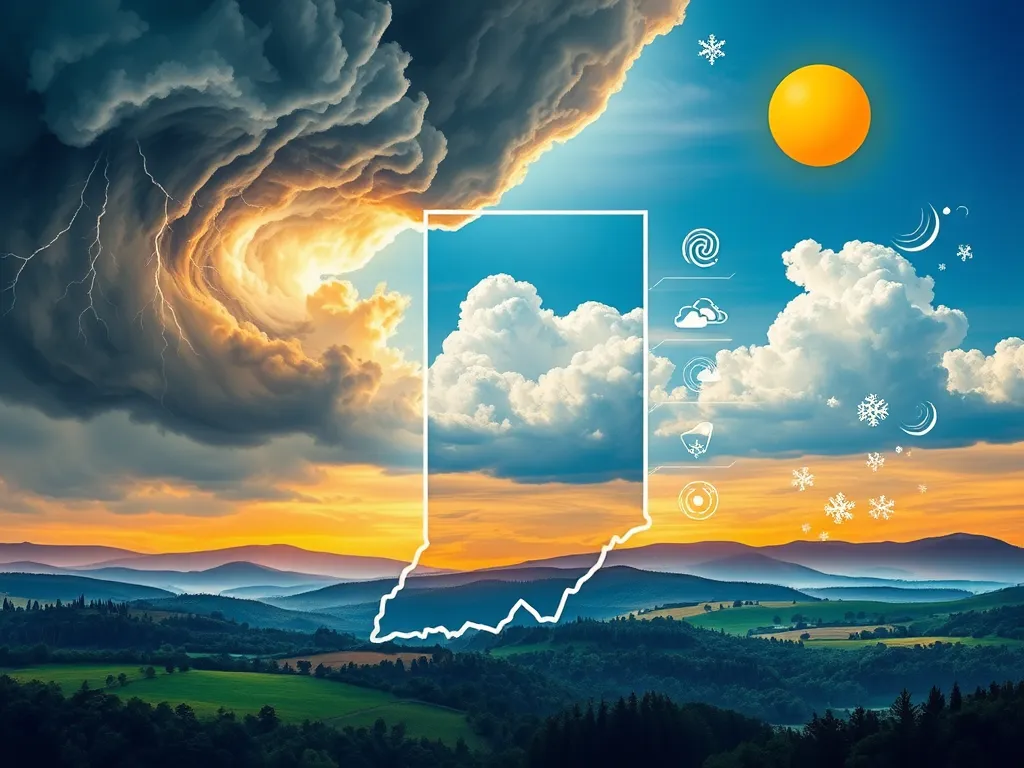Understanding Indiana Weather Patterns: A Guide for Weather Enthusiasts

Indiana Weather Patterns
Indiana, located in the Midwest region of the United States, experiences a diverse range of weather patterns throughout the year. From hot and humid summers to cold winters, Indiana's climate is influenced by various geographical features and is prone to extreme weather events.
Understanding Indiana Weather Patterns is crucial for farmers.
Indiana Weather Patterns are characterized by distinct seasons: spring, summer, fall, and winter. Each season brings its own set of weather conditions and temperatures. The state also experiences frequent tornadoes, thunderstorms, winter storms, and floods. The accurate forecasting of these weather events is crucial for the safety and well-being of the residents. Additionally, the weather patterns in Indiana have a significant impact on the state's agriculture industry.
In this article, we will explore the climate of Indiana, the characteristics of each season, extreme weather events, forecasting techniques, and the impact of weather on agriculture.
Climate in Indiana
Indiana has a humid continental climate, characterized by hot, humid summers and cold winters. The state is influenced by both warm, moist air from the Gulf of Mexico and cold air masses from the Arctic. The central and southern regions of Indiana experience more pronounced temperature variations compared to the northern regions.
The average annual temperature in Indiana is around 52°F (11°C). Summers are hot, with temperatures often reaching the 90s°F (30s°C) and high humidity. Winters are cold, with average temperatures ranging from the low 20s°F (-5°C) to the mid-30s°F (1-2°C). Snowfall is common during the winter months, particularly in the northern parts of the state.
Indiana's climate is also influenced by its geographical features. The state is located in the transition zone between the humid continental climate of the Midwest and the humid subtropical climate of the South. The presence of the Great Lakes to the north and the Ohio River to the south affects the weather patterns, as they can modify temperature and precipitation levels.
Seasons in Indiana
Spring in Indiana brings milder temperatures and increased precipitation. It is a transitional season with blossoming flowers and trees. Average temperatures range from the 50s°F (10°C) to the 70s°F (20s°C) in the daytime.
Summer is the warmest season in Indiana, with average temperatures ranging from the 70s°F (20s°C) to the 90s°F (30s°C). High humidity levels make the summers feel even hotter. Thunderstorms are common during this season.
Fall in Indiana is characterized by cooler temperatures and colorful foliage. Average temperatures range from the 50s°F (10°C) to the 60s°F (15-20°C). It is a popular season for outdoor activities such as apple picking and hiking.
Winter in Indiana can be bitterly cold, especially in the northern parts of the state. Average temperatures range from the low 20s°F (-5°C) to the mid-30s°F (1-2°C). Snow is common, and winter storms can bring significant snowfall and icy conditions.
Each season in Indiana has its own distinct characteristics, offering a variety of outdoor activities and scenic beauty for residents and visitors alike.
Extreme Weather Events
Indiana is prone to tornadoes, particularly during the spring and summer months. Tornadoes can cause significant damage and pose a risk to life and property. The state experiences an average of 20-30 tornadoes annually.
Thunderstorms are common in Indiana, especially during the summer months. These storms can bring heavy rain, lightning, and strong winds. Severe thunderstorms can produce hail and even tornadoes.
Winter storms, including snowstorms, ice storms, and blizzards, are a common occurrence in Indiana. These storms can lead to hazardous travel conditions, power outages, and school closures.
Flooding is a concern in Indiana, particularly in low-lying areas and near rivers. Heavy rains, melting snow, and ice jams can cause rivers to overflow and result in property damage and road closures.
Indiana has experienced several historical extreme weather events, including the Palm Sunday tornado outbreak in 1965, the Super Outbreak of tornadoes in 1974, and the Great Flood of 1913. These events have had a lasting impact on the state and highlight the importance of preparedness.
Forecasting Techniques
Meteorologists in Indiana use various tools and technologies to forecast the weather. These include weather radar, satellite imagery, weather models, and ground-based observations. These tools provide valuable information to predict temperature changes, precipitation, and severe weather events.
Predicting severe weather events, such as tornadoes and thunderstorms, relies on advanced radar systems and computer models. Meteorologists analyze atmospheric conditions to identify potential risks and issue alerts and warnings to the public.
While weather forecasts have significantly improved over the years, forecasting accuracy can still vary. The complex nature of weather systems and the dynamic nature of atmospheric conditions make it challenging to predict with absolute certainty. However, advancements in technology and forecasting techniques continue to enhance accuracy and provide timely information to the public.
Impact of Weather on Agriculture
Weather patterns have a significant impact on Indiana's agriculture industry. The state's fertile soils and favorable climate support a diverse range of crops, including corn, soybeans, wheat, and fruits.
However, extreme weather events, such as droughts, floods, and heatwaves, can negatively affect crop yields and quality. Excessive rain can lead to waterlogged soils and cause diseases in crops, while droughts can lead to water shortages and stunted growth.
Farmers in Indiana face challenges in managing and adapting to these weather patterns. They employ techniques such as irrigation systems, crop rotation, and the use of weather forecasting to make informed decisions about planting and harvesting times. Additionally, research and innovation in agricultural practices help mitigate the impact of weather on crops.